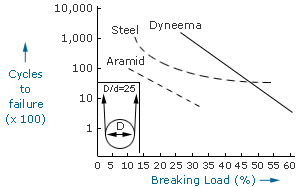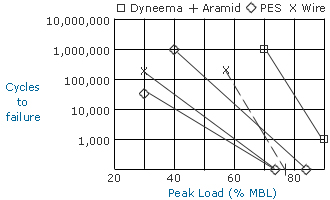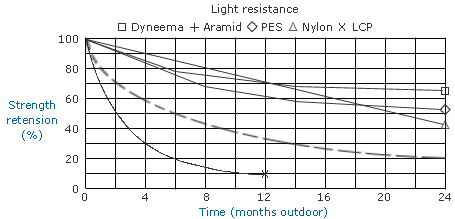| Dynamica Rope Technique parameter |
| DYNAMICA rope is the most compact Dyneema rope in the world. DYNAMICA rope is coated with a unique coating that ensures shape stability and increased abrasion resistance for longer working-life. The rope is heat-set under tension to ensure maximum strength, durability and uniformity. |
| The Dyneema fibre Properties |
|
|
|
|
| Physical Properties of Dyneema fibers |
|
|
|
|
| Water and chemicals |
|
Mechanical |
|
| Moisture regain |
none |
Creep (22oC, 20% load) |
1.10-2 % per day |
| Boiling water shrinkage |
<1% |
Axial tensile strength |
3 GPa |
| Attack by water |
none |
Axial tensile modulus |
100 GPa |
| Resistance to acids |
excellent |
Axial compressive strength |
0.1 GPa |
| Resistance to alkali |
excellent |
Axial compressive modulus |
100 GPa |
| Resistance to most chemicals |
excellent |
Transverse tensile strength |
0.03 GPa |
| Resistance to UV light |
very good |
Transverse modulus |
3 GPa |
| |
|
| Electrical |
|
Thermal |
|
| Resistance |
> 1014 Ohm |
Melting point |
144 - 152o C |
| Dielectric strength |
900 kV/cm |
Thermal conductivity (along fiber axis) |
20 W/mK |
| Dielectric constant (22oC, 10 GHz) |
2.25 |
Thermal expansion coefficient |
-12.10-6 per K |
| Loss tangent |
2.10-4 |
|
|
| |
|
| Strength |
|
|
|
|
| Dyneema is more than ten times stronger than steel per unit of weight. This means that a Dyneema rope has a slightly higher strength than a steel wire of the same dimension – but less than one tenth of the weight. |
| |
|
|
|
|
| Breaking Strength for SK75 |
Bending-bending fatigue |
|
|
|
| Diameter mm |
Minimum breaking load in tonnes |
04 mm |
1.3 t |
05 mm |
2.6 t |
06 mm |
3.7 t |
08 mm |
7.3 t |
10 mm |
10.9 t |
12 mm |
17.8 t |
14 mm |
21.7 t |
16 mm |
26.1 t |
18 mm |
35.8 t |
20 mm |
40.8 t |
22 mm |
53.6 t |
24 mm |
57.8 t |
26 mm |
59.8 t |
28 mm |
75.3 t |
30 mm |
77.8 t |
32 mm |
87.2 t |
34 mm |
92.2 t |
36 mm |
106.7 t |
38 mm |
145.6 t |
40 mm |
166.7 t |
44 mm |
193.3 t |
|

Dyneema has good bending-bending properties. However it is recommended to bend over diameters of at least five times the
diameter of the rope.
* The above breaking strengths are the breaking strengths of ropes. Splices will decrease the breaking strengths by app. 10%. All the tecnical characteristics are strictly indicative. They can not engage the responsibility of Dynamica Ropes ApS. We reserve the rights to change them without prior notice. |
| |
|
|
|
|
| Tension fatigue |
Safety |
|
|
|
 |
 |
Dyneema can sustain a very large number of peak loads
(loads close to the breaking strength). This gives a long
life and a high safe-working load. While steel-wire can
take 6500 loads at 50 % of the maximum breaking load
a DYNAMICA rope can take 10 million cycles at the same
load level. DYNAMICA rope is therefore an excellent
material for dynamic applications. |
Dyneema has a very low elongation (2-3% at break). It stores little energy and has therefore little backlash – even at hundreds of tonnes of load. This is a very important safety-feature. |
| |
|
|
|
|
| UV-stability |
|
|
|
|
| |
|
| Dyneema has a better stability to sunlight than other relevant fibres. After two years of exposure 80% of the strength is retained. |
| |
|
|
|
|
| Resistance to chemical substances |
|
|
|
|
| Dyneema is resistant to chemical substances and will not be affected by oil acids or other substances. |
| |
|
|
|
|
| Abrasion |
|
|
|
|
| Dyneema has an excellent abrasion resistance compared with other synthetic fibres (five times better than polyester). Special care has to be taken, however, in order to ensure that it moves over clean non-rusty surfaces etc.Sharp edges etc. should be avoided. |





